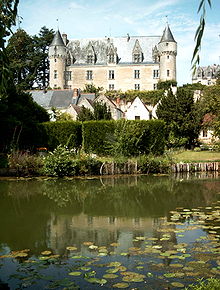- Château de Montrésor
-
The Château de Montrésor is a medieval castle with a Renaissance mansion built in the grounds, located in the French town of Montrésor in the département of Indre-et-Loire.
Contents
History
Medieval fortress
In about 1005, Fulk Nerra, count of Anjou, chose a rocky spur dominating the valley of the Indrois as the site for his captain Roger le Petit Diable ("Little Devil"), to build him a powerful fortress. Montrésor had one of the first keeps built in stone, similar to that at Loches, and two circular walls, but today only the west wall remains. In the 12th century, Montrésor fell into the hands of Henry II of England and the imposing towers at the entrance were built, as well as a part of the north curtain wall. In 1188, King Philip Augustus of France retook Montrésor from the English. André de Chauvigny, returning from the Third Crusade with Richard the Lionheart, became the new lord of Montrésor, before having to cede the castle for almost two centuries to the Palluau family.
Demolished in 1203, the castle was rebuilt in 1393 for Jean IV de Bueil by Jean Binet, who put up the enclosure wall, the gatehouse and the existing outbuildings.
Renaissance mansion
From the start of the 15th century, with the court spending more and more time in Touraine, Montrésor became a centre for courtesans and royal servants. In 1493, Imbert de Batarnay bought Montrésor to build an elegant residence in the feudal enclosure, of which only the main wing remains. Imbert was an influential councillor and chamberlain to four kings of France: Louis XI, Charles VIII, Louis XI and Francis I. This royal servant had a long tenure in this function, rare in this epoch, but he was skilful and cunning, and was present at all of the negotiations in his time - he was particularly responsible for arranging the marriage of Anne of Brittany to the king, sealing the joining of the Duchy of Brittany to the French kingdom. He was entrusted with preparations for war with Italy and the education of the children of Louis XII and François I.
The Poles
During the 17th and 18th centuries, other leading families - such as the Bourdeilles and the Beauvilliers - lived in the castle. The French Revolution marked the beginning of its decline. Around 1845, count Jouffroy de Gonsan demolished the west wing of the Renaissance logis as well as the castle chapel. In 1849, Xavier Branicki, a rich Polish count and friend of emperor Napoleon III, arrived to give new life to Montrésor; Branicki undertook the complete restoration of the castle. He equipped the house with rich furnishings and roofs and the house was the setting for sumptuous feasts with Napoléon. Branicki's descendants still own the castle.
The Château de Montrésor is listed as a monument historique by the French Ministry of Culture.
See also
External links
- Home page of Château de Montrésor
- Val d'Indrois tourist office
- Montrésor's listing at the Ministry of Culture (French)
- Ministry of Culture photos
Sources
- www.culture.gouv.fr, accessed 7 Feb 2007
- This article was initially translated from a section of this Wikipedia article « fr:Montrésor » , specifically from this version.
Categories:- Châteaux in France
- Official historical monuments of France
- Buildings and structures in Indre-et-Loire
Wikimedia Foundation. 2010.

